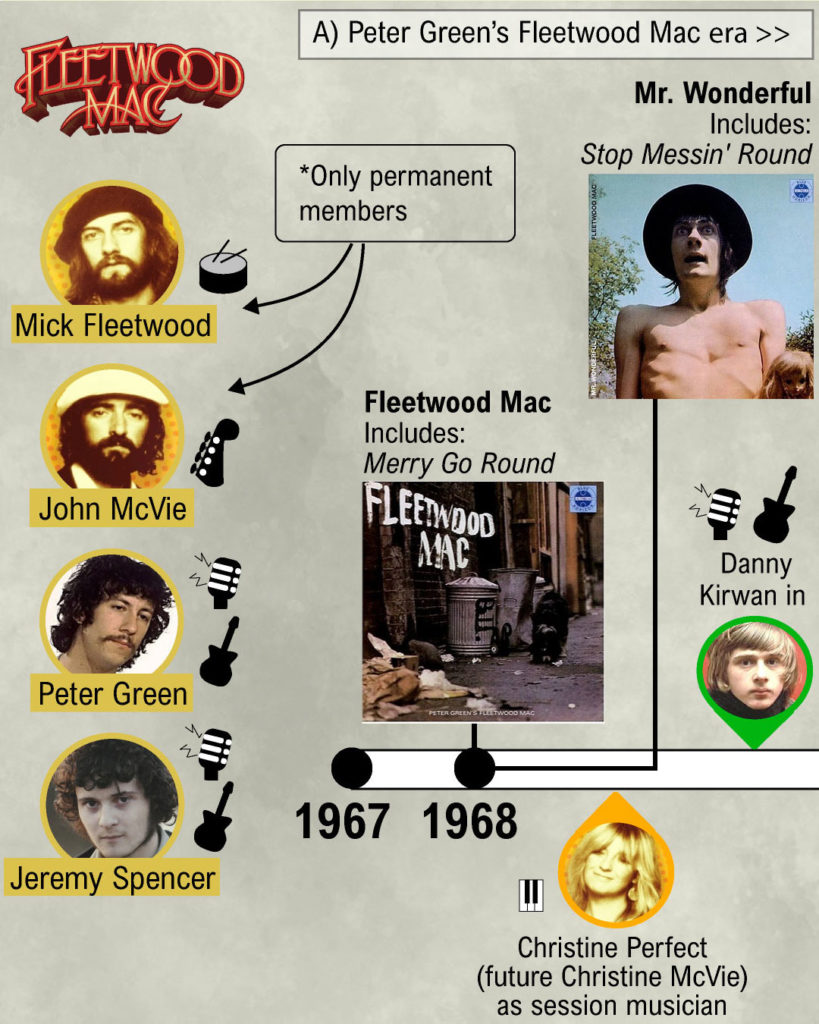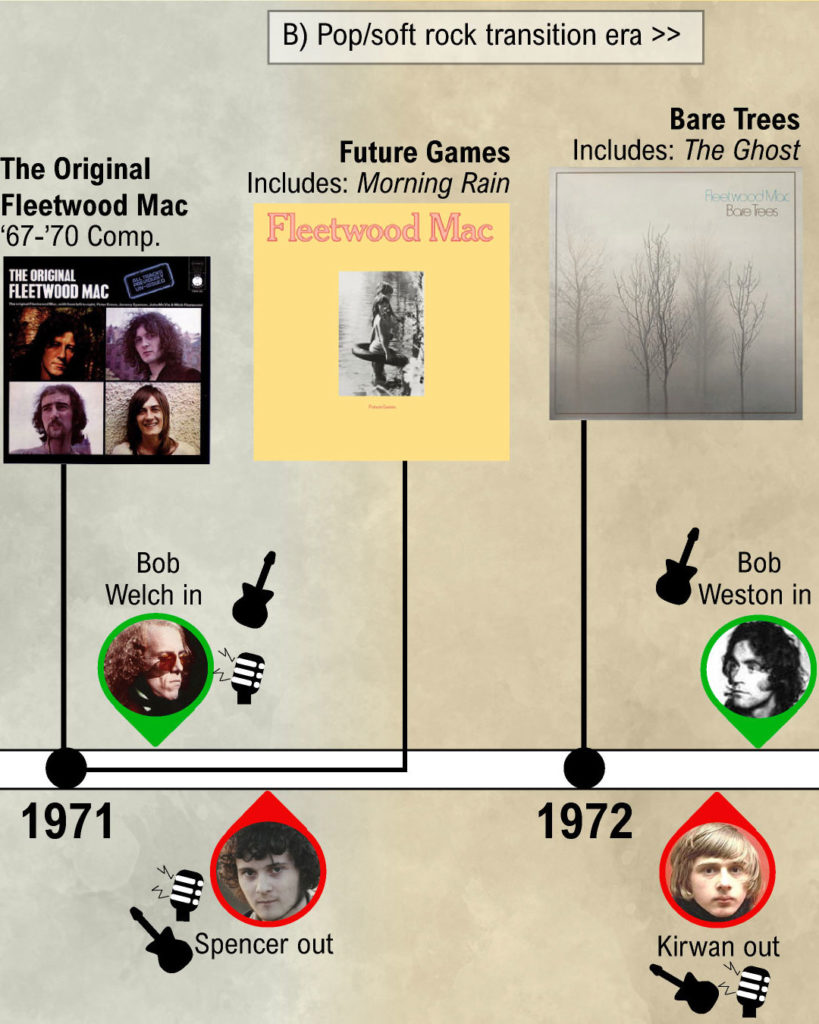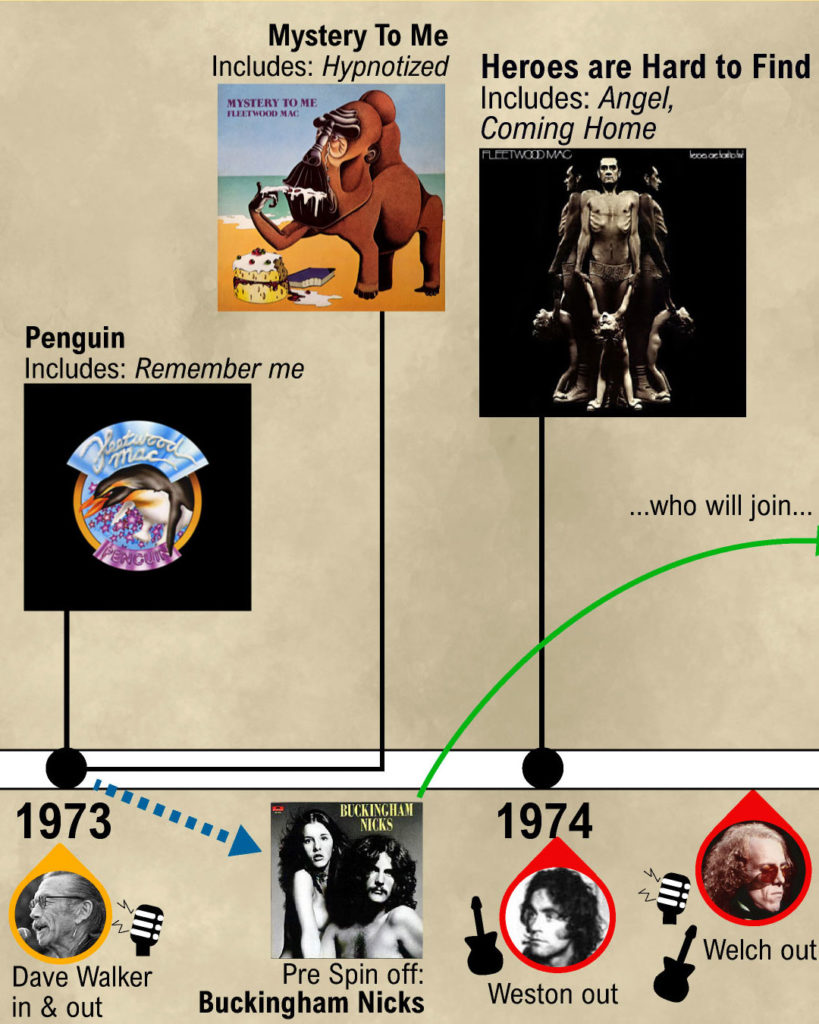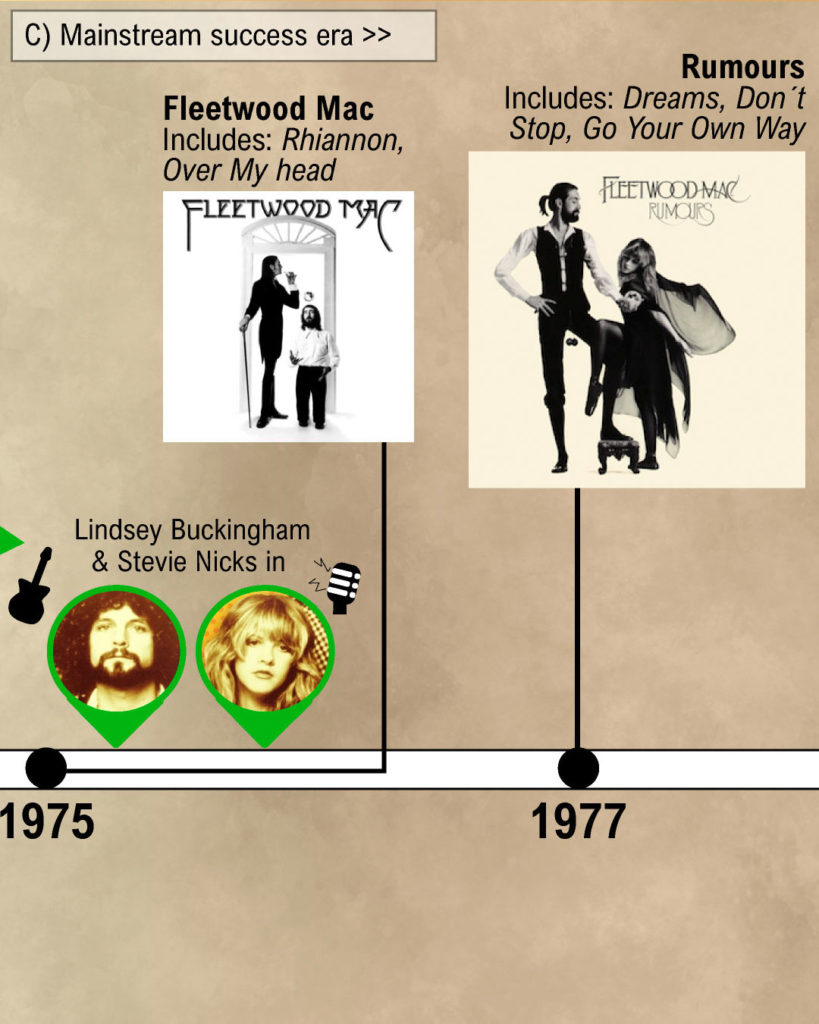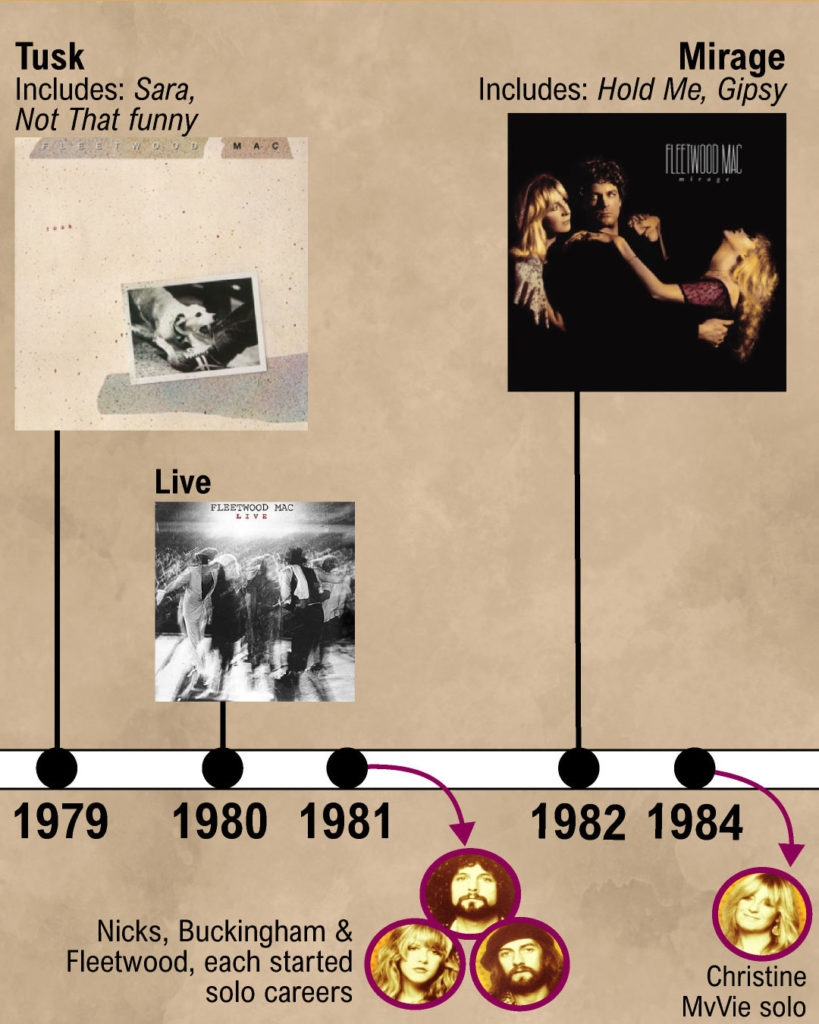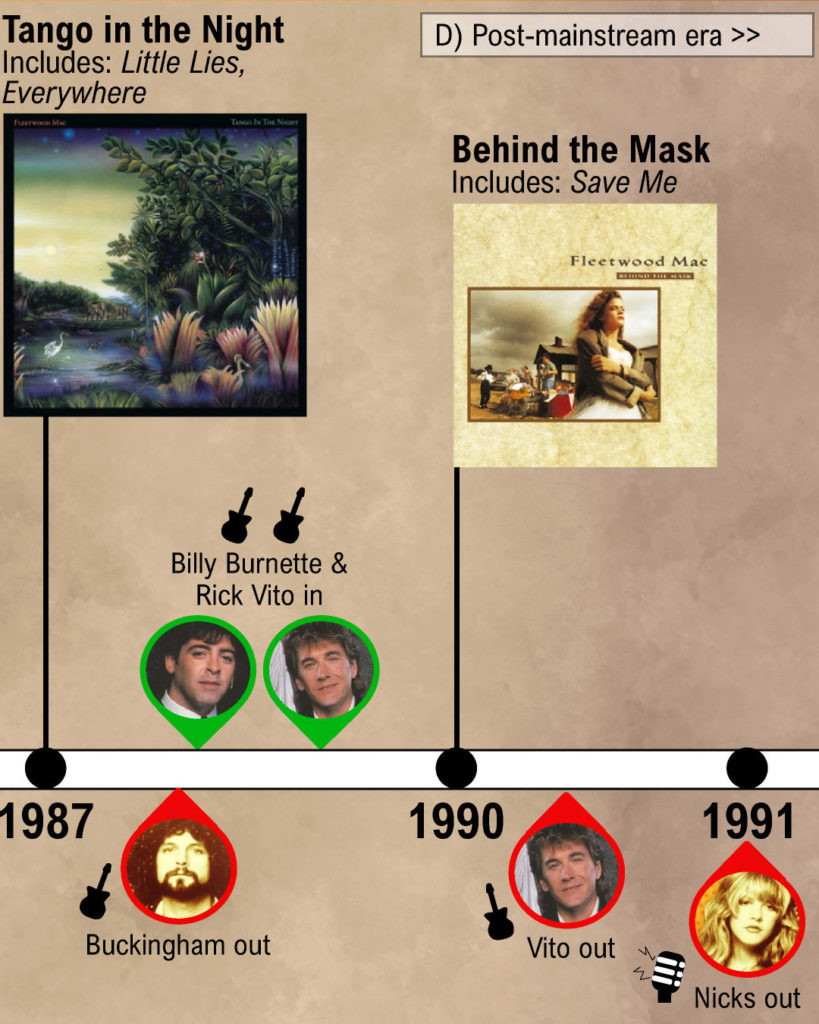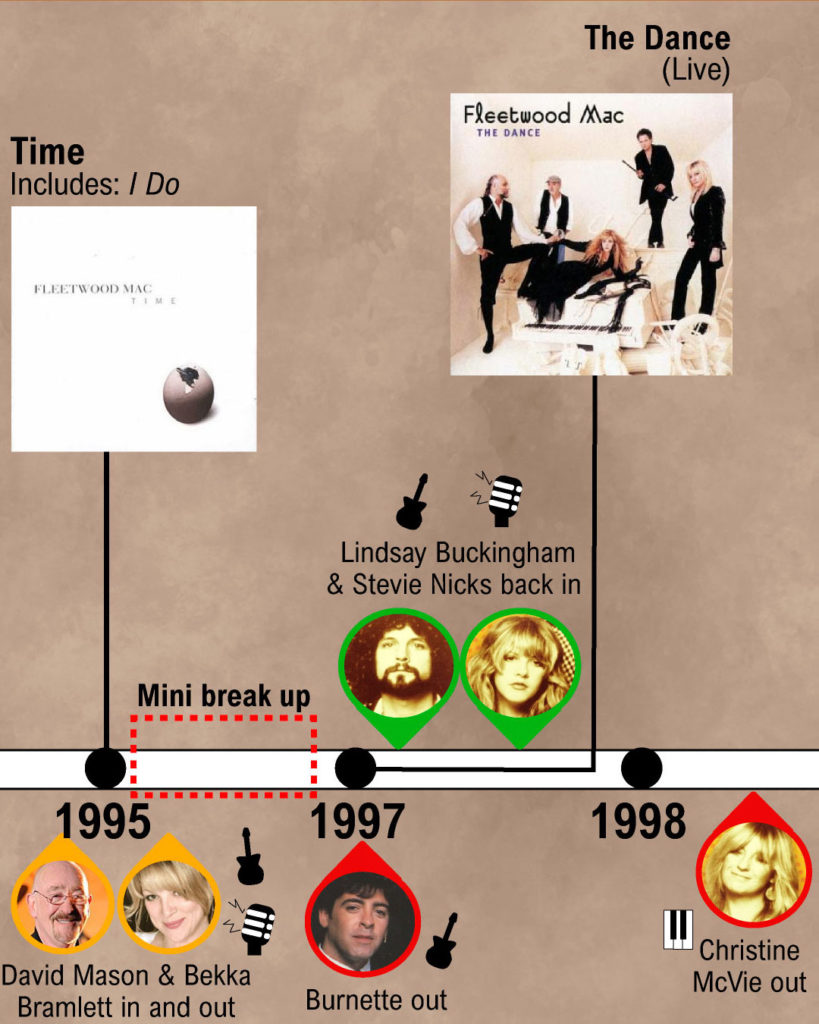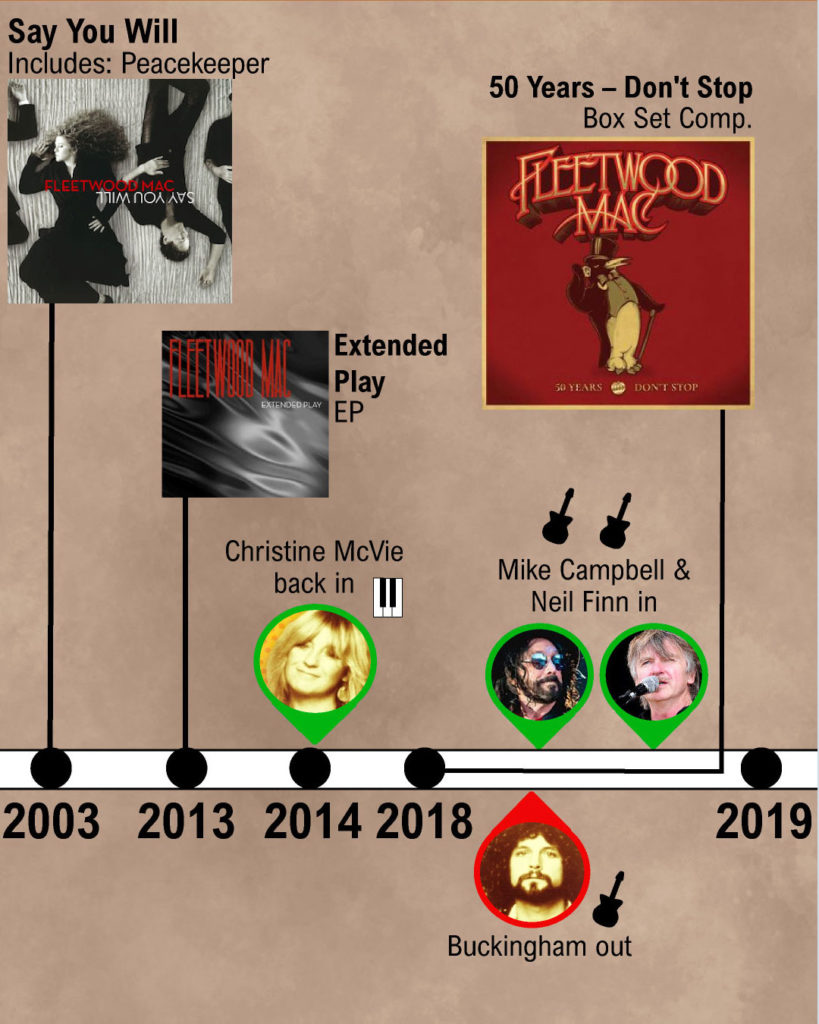Below you can find a complete timeline of the history of Fleetwood Mac. The band started as a blues rock trio in the sixties and later -after several lineup changes-, achieved massive success with Stevie Nicks and Lindsey Buckingham, with a pop-rock style.
Fleetwood Mac’s history told in 4 short chapters
Fleetwood Mac’s history is certainly one of its own: they’ve had quite a few line-up changes, with drummer Mick Fleetwood and bassist John McVie as the only constant members throughout their entire career. This is quite a notable thing, as these two musicians have never been songwriters. Really, they somehow have been the ones to glue together the Fleetwood Mac brand, no matter who else was involved.
During their music career of more than four decades, Fleetwood Mac have released 17 studio albums, as well as several live albums and greatest hits compilations. It took them ten years and ten albums to find worldwide success, which they achieved in 1977 with their album Rumours.
Taking into account all of Fleetwood Mac’s line-up changes throughout their trajectory, we can broadly break down their history into four eras, which we will recount below.
Part 1: 1967 – 1970: Blues rock era with Peter Green
Fleetwood Mac was founded in 1967, in England, by drummer Mick Fleetwood together with guitarist and singer Peter Green. Early on, they added bassist John McVie (who had just played with John Mayal) and guitarist Jeremy Spencer. Green decided to name the band after the last names of their drummer and bassist: Fleetwood Mac.
With Peter Green as a leader and main songwriter, in 1968 Fleetwood Mac released their self-titled debut album and also their second album, Mr. Wonderful. The band’s sound was reminiscent of blues music. Although they were not commercially successful, their albums were well-received by local critics.
At the end of 1968, they incorporated guitarist and singer Danny Kirwan, who as time went by gained more and more songwriting credit within Fleetwood Mac. In addition, keyboardist Christine Perfect began to collaborate with the band. Later, as a result of her marriage to John McVie, she became known as Christine McVie.
In 1969 they released their third album, Then Play on. After a live record titled Fleetwood Mac in Chicago, that same year, a drug incident caused Peter Green to lose interest in continuing in the band.
In 1970, now without the band’s former leader Peter Green, they recorded their fourth album, Kiln House. This was Fleetwood Mac’s first major line-up change, Christine McVie joined them definitely. After releasing their “Peter Green era” compilation, The Original Fleetwood Mac, John Welsh joined in 1970 and began the second part of the Fleetwood Mac story.
Part 2, 1971 – 1974: a new sound with Bob Welsh and Christine McVie
With Danny Kirwan playing an important role as a songwriter, this era of Fleetwood Mac’s history resulted in a change in sound style, away from blues rock and moving towards a pop musical direction. This change was mainly driven by Bob Welsh and Christine McVie.
In 1971 they released Fleetwood Mac¡s fifth album, Future Games. After that record, guitarist Jeremy Spencer left the band.
After the release of their following LP in 1972, Bear Trees, Kirwan was also fired from Fleetwood Mac. He was briefly replaced by Bob Weston, who collaborated with the group in two albums that the band released in 1973: Penguin and Mystery to Me. Lead singer Dave Walker participated in the first of these releases.
In 1974, guitarist Bob Weston left the band. Also, Bob Welsh announced his intention to leave the band, and as a result of this, The album Heroes are Hard was the last one of the Welsh-led era and the definitive change in Fleetwood Mac’s career.
Part 3, 1975 – 1987: commercial success with Lindsey Buckingham and Stevie Nicks
Fleetwood Mac relocated to the United States and they also welcomed a couple of young artists to their new line-up: guitarist and singer Lindsey Buckingham and singer Stevie Nicks. They both had released¡ the 1973 Buckingham Nicks album as a duo, which really impressed drummer Mick Fleetwood.
With this new “classic” line-up -consisting of Lindsey Buckingham, Stevie Nicks, Christine McVie, John McVie, and Mick Fleetwood- the band definitely took a more pop and mainstream approach to their music.
In 1975, Fleetwood Mac’s second self-titled album was released, which was well-received by music critics.
But world success came in 1977 with the next album: Rumours. During that time, the members of the band were going through various difficulties in sentimental relationships. The McVies were in crisis, as also were the Buckingham-Nicks couple and Mick Fleetwood with his own marriage.
The success of the album Rumors was really overwhelming. Some of the band’s best-known hits are included in releases, such as The Chain, Dreams, and Don’t Stop.
In 1979, Fleetwood Mac released their next effort, Tusk: an album that, even though it was well-received, did not achieve the same success as its predecessor. With a more experimental sound approach, the band members claim that it is an album that they recorded with great difficulty.
In 1981 Mick Fleetwood, Stevie Nicks, and Lindsey Buckingham, each on their own, began their solo careers.
In 1982 the group released another record, Mirage, which did not achieve the success of either of the two previous albums. Only in 1987, with the next album, Tango in the Night, the band released new and fresh hit songs. In addition to being the second most popular Fleetwood Mac album after Rumours, it marks the end of the band’s most successful era, as guitarist Lindsey Buckingham left soon after.
Part 4, 1990 – present time: tours and reunions
Since the end of the eighties, the band has stayed active, but not without difficulties. With the addition of Billy Burnette and Rick Vito to replace Buckingham, Fleetwood Mac recorded Behind the Mask in 1990. Shortly after this release, Stevie Nicks left the group.
After Vito’s departure from the band, Fleetwood Mac put together a new line-up, which recorded just one album: Time, in 1995. This line-up included Mick Fleetwood and the McVies, guitarists Billy Burnette and David Mason, as well as singer Bekka Bramlett.
After a brief period of no activity, the most successful Fleetwood Mac line-up reunited together again and recorded the live album, The Dance (1997). The remaining members, The McVies and Fleetwood, were rejoined by Stevie Nicks and Lindsey Buckingham.
In 1998, Christine McVie left the band. This is why Fleetwood Mac’s last full-length album, Say You Will (2003), does not feature all of the group’s most popular line-up in its entirety.
After a decade without new material but with several shows and greatest hits albums released, in 2013 Fleetwood Mac recorded an EP appropriately titled Extended Play. This is the last album including original Fleetwood Mac material.
The band kept touring and playing live every once in a while. In 2014 Christine McVie rejoined Fleetwood Mac. Still, this did not last long: in 2018 Lindsay Buckingham left the band again and was replaced by two other guitarists: Mike Campbell and Neil Finn.
On November 30, 2022, Christine McVie passed away due to health issues. All surviving members of Fleetwood Mac expressed their condolences about this sad event.
Fleetwood Mac Line-up specifications throughout their discography
With various line-ups, Fleetwood Mac have released a total of 17 studio albums. Find the complete list below, with indications about which line-up that recorded on each LP.
- Fleetwood Mac (1968): Peter Green, Jeremy Spencer, John McVie, Mick Fleetwood.
- Mr. Wonderful (1968): Peter Green, Jeremy Spencer, John McVie, Mick Fleetwood.
- Then Play on (1969): Peter Green, Jeremy Spencer, Danny Kirwan, John McVie, Mick Fleetwood.
- Kiln House (1970): Jeremy Spencer, Danny Kirwan, John McVie, Mick Fleetwood.
- Future Games (1971): Bob Welsh, Christine McVie, Danny Kirwan, John McVie, Mick Fleetwood.
- Bare Trees (1972): Bob Welsh, Christine McVie, John McVie, Mick Fleetwood.
- Penguin (1973): Bob Welsh, Bob Weston, Christine McVie, John McVie, Mick Fleetwood.
- Mystery to Me (1973): Bob Welsh, Bob Weston, Christine McVie, John McVie, Mick Fleetwood.
- Heroes are Hard to Find (1974): 1973) (Bob Welsh, Christine McVie, John McVie, Mick Fleetwood.
- Fleetwood Mac (1975): Stevie Nicks, Lindsay Buckingham, Christine McVie, John McVie, Mick Fleetwood.
- Rumours (1977): Stevie Nicks, Lindsay Buckingham, Christine McVie, John McVie, Mick Fleetwood.
- Tusk (1979): Stevie Nicks, Lindsay Buckingham, Christine McVie, John McVie, Mick Fleetwood.
- Mirage (1982): Stevie Nicks, Lindsay Buckingham, Christine McVie, John McVie, Mick Fleetwood.
- Tango in the Night (1987): Stevie Nicks, Lindsay Buckingham, Christine McVie, John McVie, Mick Fleetwood.
- Behind the Mask (1990): Stevie Nicks, Billy Burnette, Rick Vito, Christine McVie, John McVie, Mick Fleetwood
- Time (1995): Bekka Bramlett, David Mason, Billy Burnette, Christine McVie, John McVie, Mick Fleetwood
- Say You Will (2003): Stevie Nicks, Lindsay Buckingham, Christine McVie, John McVie, Mick Fleetwood.


